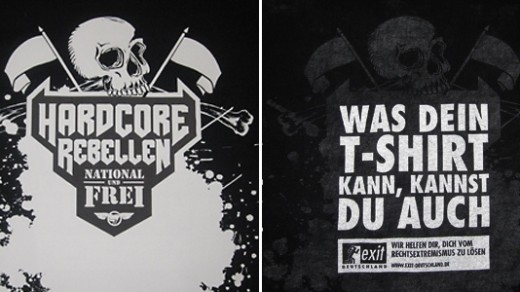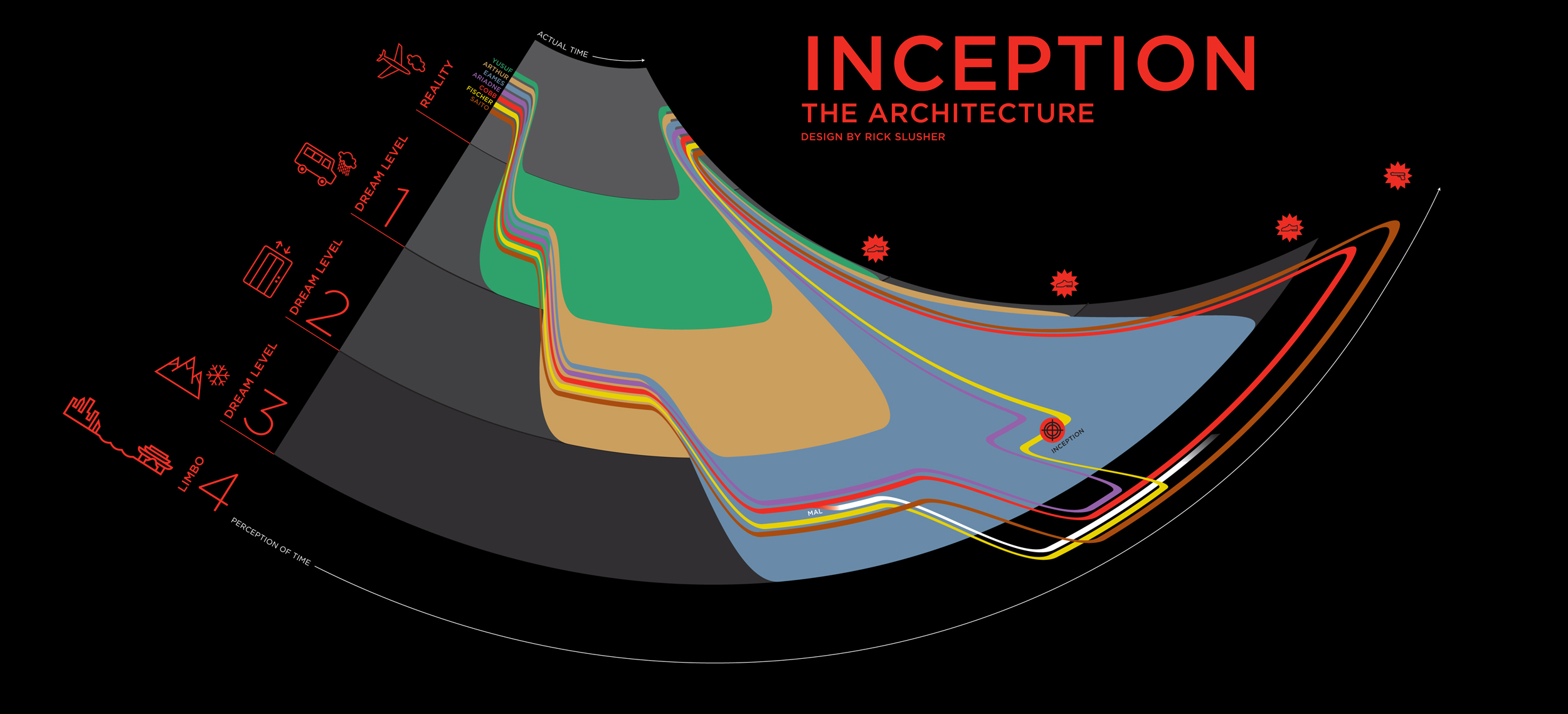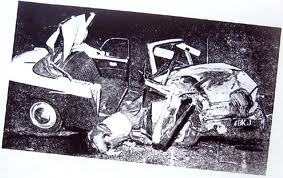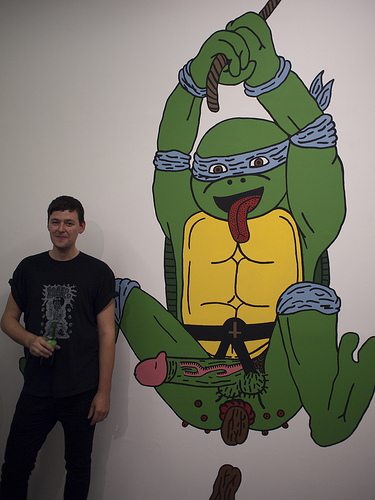0 notes
Rinsing Out Fascism

These t-shirts handed out at a neo-Nazi concert challenge the wearers’ politics by changing message in the wash. The campaign was conceived by Exit, an organisation which encourages individuals to leave the far right in Germany. The message reads: ‘If your t-shirt can do it, you can do it too — we’ll help you get away from right-wing extremism.’ According to Bernd Wagner of Exit, the t-shirts not only reached some 250 of their intended target but simulated debate and conversation within both the far right movement and German society at large. Result.
Via The Next Web.
0 notes
Netmasked Avengers – The Coming of the Digilantes
Not quite the Big Society our current leaders wished for, but we’ve seen some signs, over the past few chaotic days, of Londoners taking the protection of the streets into their own hands (Dalston shop-owners, we salute you)
Now we read in Forbes that a group of community-minded developers are working to identify some of the ‘malefactors’ from the London riots themselves, the high-tech way.
Un-inclined to suit-up and hit the streets, RLSH-style, these more technically-savvy crime-busters propose to run images of the rioters through off-the-shelf facial-recognition software, to put names to the shameful images of the past few days.
The plan might yet, we, guess, run aground on the rocks of the Law, but we wish them well in their quest.
UPDATE 15 August 2011: Evidently their software didn’t make the grade, and they’ve given up, to slink back into the shadows from whence they came…
1 note
Raw Muscle: Premier
Film maker and friend of BST, Lea Gratch, will be premiering her latest work – Raw Muscle – in situ at Muscleworks Gym in East London this Wednesday.
The film is an in-depth look at the subculture of body building and follows on from Lea’s earlier documentary about the Hells Angels’ annual Bull Dog Bash. Doors open at 7.30pm.
0 notes
Lytro In Depth…
Following our post on Lytro’s revolutionary Light Field camera technology, we emailed them with some questions.
The nice people at Lytro’s PR agency (The OutCast Agency) have replied, and we offer you their unedited answers, below.
The most interesting point to note, is that it seems Lytro’s Light Field tech will play friendly with other lenses – so in theory it’s not out of the question to shoe-horn it into an existing camera-bag full of legacy kit. That’s exciting for any pro photographer with an investment in ‘classic glass’. More ambiguous is their claim that 'we make use of the pixels you would traditionally throw away’ – they seem to be focussed here on most people’s on-screen viewing experience rather than the (admittedly) few of us who produce large, high-resolution prints, and whom rather than 'throwing away’ pixels, resort to 50+ megapixel digital backs for fashion shoots… if indeed they’re counting on substituting depth information for resolution, then I admit to a diminished interest in their technology. 'Better than HD’ resolution is, after all, fewer pixels than I’m using typing this on my MacBook…
But wait and see. Of course, we’ll only really be able to tell you more when we get our hands on one of their cameras…
BST: When will we get to see a product shot of the camera?
Is the technology in theory compatible with legacy lenses? From a quick look at Dr Ng’s original papers, it would seem that the Light Field microlenses are positioned after a traditional lens assembly – so is it possible that a Light Field body could work with classic lenses?Lytro: The camera will be released later this year.
Why release what appears to be a consumer camera at a point where the consumer camera market is rapidly losing market share to smartphones?Lytro’s light field technology works with any camera that involves a sensor behind a lens. The magic is in the light field sensor and the software the processes the light field into pictures.
Any licensing deals in the works with the big players (ok we don’t really expect an answer to that)?We have a significant lead in making this technology available to consumers and believe that we can forever change how we all take and experience pictures. The camera market is in fact projected to grow from $38B in 2010 to $44B by 2015 and we believe Lytro technology could even expand that demand.
Is the system *in theory* capable of working with video? We’re excited both about single-lens 3D and real-time depth-based compositing!Our current strategy is to introduce this technology to people in a Lytro-branded camera that is fast, simple and magical to use.
The demo images on the site are fairly low-rez – is there a tradeoff between resolution and the Light Field capabilities?Video is entirely possible with light field. It will just require solving difficult software challenges. It is on our long-term roadmap but will not be available in our first product.
The amount of megapixels, or resolution, is fundamentally about how big of a 2D photograph one can print. So, when viewed on even big screen monitors, the 14 Megapixel camera ends up throwing away over 90% of the pixels. In fact, the lens on most point-and-shoots have a fraction of the resolution of their sensors! With light field technology, we make use of the pixels you would traditionally throw away. We use those pixels to retain the depth information of the scene. This has many benefits including, focusing after the picture is taken to any subject in the scene, on to displaying 3D pictures, even holographic when that is available. Light field resolution provides better than HD quality today.
0 notes
Lytro
Lytro.com / Eric Cheng – click the kitteh!
Photography has always required a few technical decisions before shooting. You (or your expert proxy, the camera’s computer) need at the very least, to focus the lens and set the exposure, based on your artistic intent, the subject at hand, its setting, and various parameters related to constraints specific to your lens and sensor or film stock.
Those choices always take a little time, and define irrevocable characteristics of the final image. A seriously out-of-focus subject will always remain a blur, while a blown-out highlight will always glare whitely and detail-less out of the print. Short of repainting the subject, there are limits even to post-processing stalwarts such as Photoshop.
But of course ‘exposure’ and 'focus’ are concepts of optical engineering, of the process of photography, not characteristics of the world. The visual world is a field of light, from within which field a photograph is constructed by placing the limitations of a specific combination of lens and sensor at a specific location, at a point of time. The visual world itself is neither focussed nor unfocussed, neither over- or under-lit. It is merely light.
What if we could capture more fully a description of that field of light, and, after the fact, at our leisure, decide on what should hold focus, what should be the depth of field, what should be a highlight, what a mid-tone, what deep mystery of shadow? Aesthetically, such a choice offers obvious freedoms. Pragmatically, it means that time need not be wasted on camera-system configuration, but rather in getting access to, and framing the shot –- important for sports, street and wildlife photographers alike.
Two emergent technologies offer to deliver on that promise of leisurely, post-production exposure and focus. On the exposure front, High Dynamic Range sensors have been 'the next big thing’ for several years now. When it comes to focus, the revolution may have just taken place. US-based startup Lytro has decloaked from stealth mode to announce its first Light Field camera, based on founder and CEO Dr. Ren Ng’s academic research. The camera itself is still vapourware, but Lytro’s algorithms are demonstrated in interactive Flash images on their site. Click on any part of an image, and hey presto, it springs into focus. This is a genuinely disruptive imaging technology, and comes with other interesting claims, including massively improved low-light performance, and single-lens 3-D.
It all looks cool – though rather low-rez – in the demos. Given the potential value of their intellectual property, we’re surprised that Lytro aren’t focussed (ahem) on licensing it out to the big players. Instead, they are (apparently) planning to swim their cool tech, under the flag of a startup brand, into the perilous waters of the consumer electronics market, buoyed only by a vapourware product and a brand positioning – living pictures – which is a weak undersell of the scope of their innovation. One has to wonder, why not aim elsewhere? Why not focus on the professional photography customers to whom Lytro’s very real benefits should have a high commercial value? Why, indeed? Is it possible, for example, their Light Field technology throws away resolution in exchange for its magic? Maybe there’s no way to integrate it with legacy optics, which would reduce its utility for professional photographers? There’s simply not sufficient information on Lytro’s site to tell.
Damn, though, their tech is cool, and double-damn I want one of their cameras, to take for a spin some steamy night at Superstore. We’ve asked them for an interview. We will keep you posted. In the meantime, we’re off to read Dr Ng’s original research papers…
UPDATE – some answers from Lytro…
0 notes
Vanishing Point
Christiane F is a David Bowie-soundtracked ‘70s film about a young girl’s descent into heroin addiction. The film – if you haven’t seen it – is a bit of a morality tale but worthy of note for the fantastic scene where Christiane and her friends go rollicking through a subway to the sounds of 'Heroes’ (from 6:58).I often refer back to this clip when thinking about 'youth culture’ and what that label really means. This is a little glimpse of what being young feels like. It’s a clip about being reckless and guileless and joyful and living in the absolute now. At 36, I know that I am officially old because I’ve started to think that teenagers now a) all dress the same b) are obviously nowhere near as cool as teenagers from 'my time’. I am, of course, wrong on both counts. Because I’m no longer there.
We’ve written here before about how the internet and specifically social media has enabled young people to 'remove’ themselves from the mainstream. Traditionally, young people have done this through tribes and youth movements - be it the heroin-based club scene in Christiane F or Emo. And there is an ocean of thinking about how this links back to identity and belonging and so on. But it is the act of removal that so-called trend-spotters and yoof culture analysts always seem to miss.
As an adult, you’re not supposed to be able to see or read some aspects of youth culture. Like a teenager refusing to friend her mum on Facebook, if you’ve been allowed in you’re probably not seeing the genuine article. Likewise, identifying and labelling youth trends damns them to page 8 of the Sunday Times Style – and what fresh hell is that?
Full disclosure: I used to work at The Future Laboratory as a trends analyst. That’s analyst *not* spotter.
With thanks to Jess, for reminding me.
0 notes
The Ghostmodern Condition
Take a a Platonic solid, a cube. Then…
- Divide every face of the cube into 9 squares, like a Rubik’s Cube. This will sub-divide the cube into 27 smaller cubes.
- Remove the cube at the middle of every face, and remove the cube in the center, leaving 20 cubes.
- Repeat steps 1–3 for each of the remaining smaller cubes. Forever.
At each stage, you’re left with a fractal curve called a Menger Sponge:
 [More animation here]
[More animation here]At the limit point of infinite recursion, you’re left with a cube which has infinite surface area, but which is all hole.
We offer this empty solid up as a model of an aesthetic we’re labelling ghostmodernism within which – of the spine, the spire, the span that holds the form to one form: the wire in the rose – only that span, the form of the form, remains, as the form itself has now become infinitely detailed, yet in that process, of the void.
So, you ask, what does ghostmodernism look like, in the wild?
Exhibit One – this exquisite laser-cut chair from Gallery Fumi:
 [view full-size on Flickr]
[view full-size on Flickr]Exhibit Two – the plot of the film Inception, while having the surface modernist form of a heist thriller, recurses down into the frozen time ‘down there’ deep in stasis of Cobb’s dreamworld, the narrative 'arc’ now a pathological curve.

The ghostmodern is not inherently evanescent, although I’d happily claim Doug Starn’s Big Bambu installation as an edge-case.
These thoughts also return to us our dreams of the hyperbolic surfaces of modern being – there’s another post coming soon linking these thoughts…
0 notes
0 notes
Future PR

It sounds fantastical but – according to Volvo – it’s true. According to the Volvo site:By 2020, nobody shall be seriously injured or killed in a new Volvo.
“The goal is unique in that Volvo Cars has designated a year and is showing a social responsibility that also extends to people in other vehicles and pedestrians,” says Anders Eugensson, safety expert at Volvo Cars. ”We are very clear about the fact that our cars should not negatively affect other people at the moment of an accident. In addition, no unprotected roadusers should be seriously injured or killed.” Whilst other car companies have also hit on the potential of future tech for safety, no one brand has been so bold as to turn it into a PR-able brand story. Which is what Vision 2020 is. And – vitally – it’s entirely credible.This statement from 2008 clearly formulates a long-term vision to create cars that will not crash. Volvo Cars’ strategy to achieve Vision 2020 includes cooperating with social partners, integrating preventative and protective safety systems into the car and, in particular, to better understands people in traffic situations. Driver behaviour is a contributing factor in over 90 percent of all accidents.
According to Ed Kim, an analyst at automotive research firm AutoPacific, the zero-fatality goal is achievable. Within the next ten years, the confluence of safety technologies such as road sign recognition, pedestrian detection and autonomous car controls will produce far safer cars. Vision 2020 is a Utopian vision which suggests that the auto wreck - that horror symbol of the 20th Century - could be consigned to the past. A vision that Volvo now has the potential to own.
Story stolen with glee from Slashdot.
Image: Car Crash by Andy Warhol. This post originally appeared on Anne-Fay’s work blog: Noise.
0 notes
NINJA TURTLE SEX MUSEUM

Those suffering from hipster fatigue should visit Five Hundred Dollars for a reminder of why Hackney became so hip in the first place. James Unsworth’s show is a return to form for East London art, a scene otherwise awash with indulgence and ketamine. Go see.
